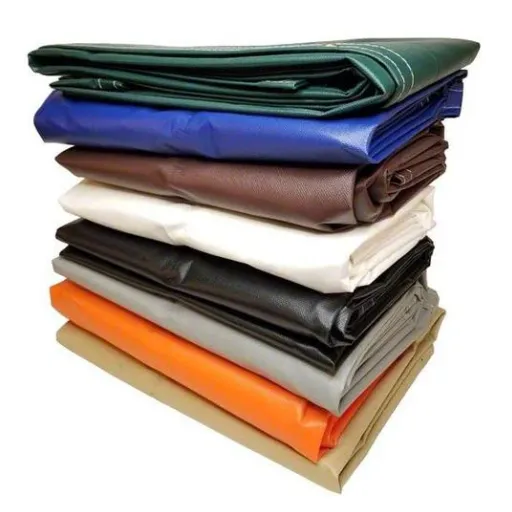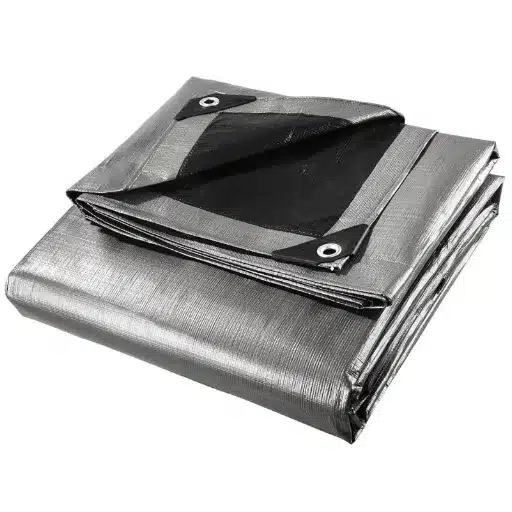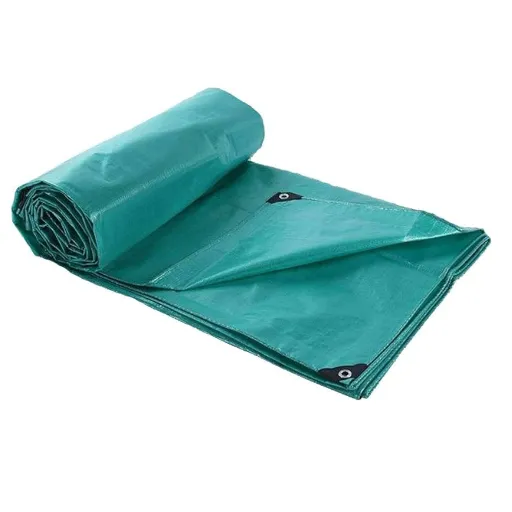Greenhouses are an essential support for every gardener who wishes to prolong the growing season, safeguard the plants against prickly weather, or provide the ideal growing condition for the plants. The covering is the key element of every successful greenhouse, a rather simple part that significantly influences the regulation of temperature, lighting, and humidity. This manual takes you to the world of heavy-duty greenhouse covers, giving special attention to greenhouse plastic sheeting. If you are a full commercial grower, a casual hobbyist, or just a beginner in greenhouse gardening, this guide will walk you through the proper selection of materials, the longest life possible for a cover, and the best light transmission for the support of plant health and productivity. At the end, you will have the understanding required to make wise choices and to have your greenhouse well-equipped to thrive under any circumstances.
Understanding Greenhouse Covers
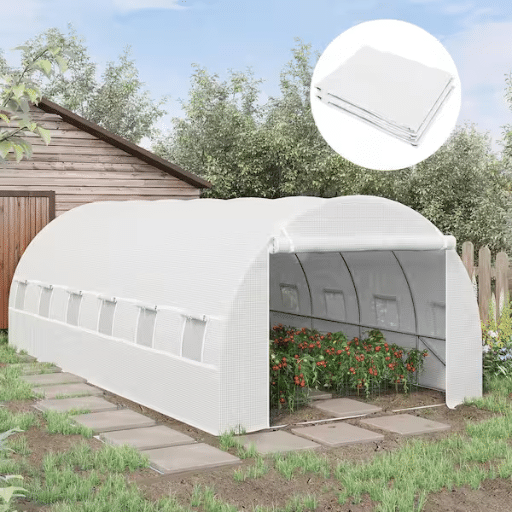
What is a Greenhouse Cover?
A greenhouse cover is the protective layer that encloses the greenhouse and thus the plant growth will be controlled. This protective layer was made from polyethylene, polycarbonate or glass, the greenhouse cover is serving a lot of purposes. The main ones being temperature control, humidity retention, and light supply for photosynthesis, to mention a few. The modern greenhouse covering is designed to be very durable, UV resistant, and at the same time with high thermal efficiency, thus making it possible for growers to maintain the best possible conditions during all the seasons. The searches of the recent data indicate that the growers’ interest is turning towards the covers with advanced light diffusion properties, which have the capacity of distributing sunlight evenly, thereby reducing the hotspots and promoting uniform plant growth. Consequently, it goes without saying that the right kind of greenhouse cover must be selected according to the requirements of the crops and the climate.
Types of Greenhouse Coverings
Glass Covers
Glass has been hailed as the ultimate covering for greenhouses for a long time and that is mainly because of its wonderful light-transmitting properties, which are about 90% on average. Today, tempered glass makes it even more durable as it can withstand breakage caused by events like hail or heavy wind. But the recent search trend data suggests that farmers are looking glass alternatives, particularly in areas where cost and insulation are the major factors.
Polycarbonate Sheets
Polycarbonate searches are always on top and they are showing consistent interest in the durability and thermal insulation properties of the material. The products that are built with multi wall polycarbonate sheets are the best-case scenario since they provide the best light diffusion while at the same time keeping their structural integrity intact. The panels are 200 times strong than glass which makes them a reliable option even in nasty weather.
Polyethylene Films
Polyethylene films offer the greatest flexibility and are also the least expensive option. They are widely used in both commercial and amateur greenhouses. The latest trend has pointed out the need for polyethylene films that have UV stabilization as well as anti-drip additives in them which in turn not only enhances the quality of light but also prevents the condensation on the inner surface thus contributing to the crop being healthier.
Acrylic Covers
search the last year shows that acrylic panels have been the subject of most inquiries, mainly due to the fact that they are very clear and have a long life span of up to 30 years. Though not as durable as polycarbonate, they offer excellent light transmission and UV protection so they can be used in high-light areas.
The above-mentioned factors and current requirements of management might point to a direction towards using no weight, energy-efficient, and long-lasting materials that will not only spoil the light but also create an ideal atmosphere for plant growth.
Benefits of Heavy-Duty Greenhouse Covers
Heavy-duty greenhouse covers are loaded with advantages that are in sync with the recent industry research findings and environmental needs. These covers have been designed to resist bad weather, for example, strong winds, heavy rains, or hail, and thereby guaranteeing the structural strength of the greenhouse. They are using advanced UV stabilization technology that reduces the risk of the material being broken down over time, which takes place not only in the case of the functional life span but in the case of the light transmission rates also.
The data that was gathered recently pointed out the fact that greenhouse coverings with thermal insulation abilities decreased by a very significant amount the energy that was consumed by the controlled atmosphere due to the fact that the internal temperature was kept constant. This energy efficiency is not only a reduction in operational costs but an alignment with global sustainability goals as well. The fact that the materials have a long life span also lessens the frequency of replacements, thus they are an economically viable option for modern agriculture. The combination of these characteristics results in higher productivity, better quality crops, and adaptability to both commercial and small farming operations.
Choosing the Right Greenhouse Plastic
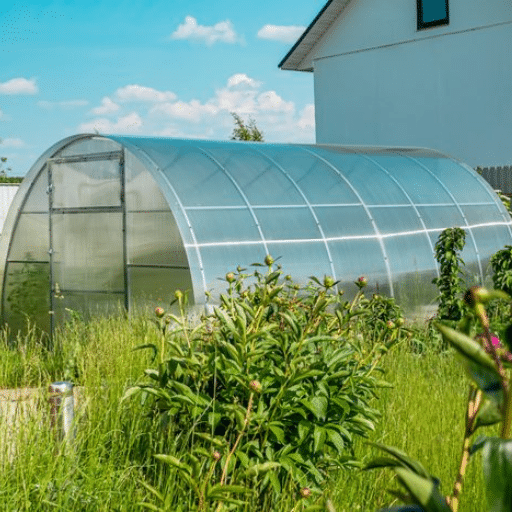
Deciphering Mil Thickness
Mil thickness is the primary factor that determines the selection of greenhouse plastic since it has an impact on the durability, insulation, and light transmission of the product. The word “mil” is a measurement unit that defines one-thousandth of an inch (0.001 inches). Usually, the thickness of the greenhouse plastic is between 4 and 12 mils. The standard 6 mil covering, for instance, is a robust choice that offers just the right balance between durability and cost-saving, whereas thicker alternatives, like 10 or 12 mils, are being used where more insulation or protection from the impact of heavy winds and hail is needed.
The application of data and statistics has shown that the thicker plastics are, the more wear and tear these plastic coverings would resist, which makes them suitable for possible long-term usage. Though, the downside is that these coverings might cause slight reduction in light transmission compared to the thinner ones. Recent studies and searches indicate that growers are often looking for 6-mil plastics that would serve multipurpose needs because they are strong enough for the majority of the climates and at the same time provide very good light diffusion. In the end, the mileage thickness that is regarded as ideal is dictated by the particular environmental conditions, the needs of the crops, and the financial limitations.
Greenhouse Covers UV Resistance
One of the most important features of greenhouse covers is the UV resistance as the ultraviolet radiation that hits the material for long periods can cause its deterioration. Manufacturers have now shifted to producing greenhouse plastics that incorporate stabilizers, built to last, which make over the years by not allowing the material to get brittle or discolored. Massive research from Google says that a good portion of users is specifically interested in covers that would last 4 to 6 years at least in high UV exposure.
The degree of UV resistance is determined by the geographical area, sun intensity, and the quality of the agents that stabilize the product during its manufacturing. First-rate greenhouse covers use sophisticated UV filters, whose function is to reflect or absorb the harmful radiation without altering the visible light that has to be transmitted. Crop growers in areas with very severe UV situations should not hesitate to buy greenhouse covers that come with UV protection as they will have good and long-lasting performance hence optimal crop conditions will be maintained and cost of frequent replacement will be saved.
Comparing Polyethylene and PVC Greenhouse Covers
When you compare poly and vinyl (PVC) greenhouse covers, you must take into account a number of important factors that will eventually help you to find the right product for your specific application. Polyethylene covers are the most popular type of plastic greenhouse covering because they are inexpensive and their installation is pretty straightforward. These days, poly coverings are produced in a way that they consist of several layers with the incorporation of UV stabilizers, thus persistence and light scattering characteristics have been developed which together help in plant growth. Poly coverings also include the high tech methods that are used with them for they are able to hold heat, making them very economical in energy, especially in colder areas. Yet, poly coverings’ life expectancy is usually shorter, roughly 3-5 years, depending on the climate and care given.
PVC coverings, on the contrary, give the growers more than just the best quality. PVC has an extended life span of 5-10 years and thus is the more preferred option in the places that face strong winds, heavy snow, or extreme weather conditions. Their inherent properties also provide good insulation which, in turn, helps to maintain the temperature inside the greenhouse more steady. However, PVC is more costly and it requires a very precise type of installation so as to prevent problems like sagging or ripping from arising. Besides, if not protected with the adequate amount of stabilizers, PVC can eventually succumb to UV rays and thus would be in need of regular coats or addition of additives to keep it going for longer.
In the end, the decision of whether to go for poly or PVC covers is made based on a combination of factors such as budget limit, climate, and particular agricultural needs. For the short-lived and low-budget solutions, the solution is obviously poly covers. However, the situation of PVC greenhouse covers is quite opposite as they are the right option for long term strength and toughness in difficult weather conditions.
Heavy Duty Greenhouse Cover Options
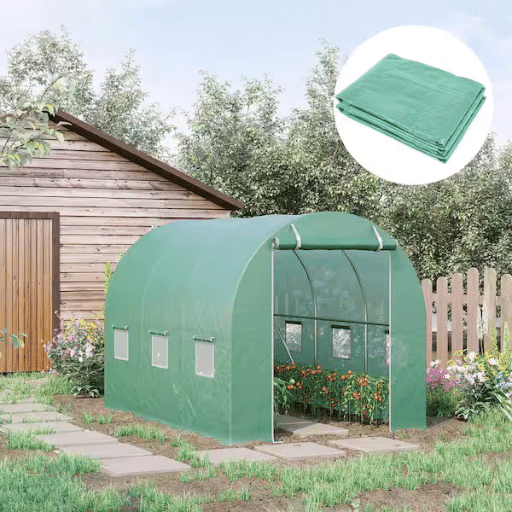
Top Features of Heavy-Duty Greenhouse Covers
Heavy-duty greenhouse covers are made of very strong materials, providing really great endurance, excellent heat retention and protection from outside elements. The list below gives these features that make them a high-end choice for professional and hobby growers:
UV Resistance
High-tech greenhouse covers are applied with ultraviolet radiations blockers to avoid the deterioration that will be produced by the sun for a long time. The assurance of integrity and clarity for a long time is also one of the ways that the plant will be supported and more light is passed through for the process of photosynthesis to take place.
High Tear Strength
Using tough materials such as polyethylene or PVC, heavy-duty covers are quite amazing in their strength-ability to withstand pulling. This means they will not tear down in terrible winds, hail storms, or any mechanical stress which will make the operation dependable in different climate conditions.
Thermal Insulation
The latest covers will usually have built-in thermal insulation properties. The double-layered design or coating of materials will decrease the loss of heat, keep the temperatures inside the same, and make the use of energy more efficient, especially in places where the temperatures fluctuate a lot.
Condensation Control
A lot of heavy-duty greenhouse covers have the application of anti-drip treatments, which will help in reducing the collection of drops of water inside the greenhouse. This will not allow the crops to be affected by the bacteria of mold, the diseases of the fungus, and the irregularity of light that is being diffused, thus the environment of growing will be healthier.
Light Diffusion Capabilities
New technology makes it possible to have these covers offer soft and evenly spread light, which not only reduces the risk of plants getting burnt but also makes the growth even. Besides, the light diffusion gets rid of deep shadows that might slow down the development of the plants.
Extended Lifespan
Due to their multi-layer design and use of high-quality manufacturing techniques, heavy-duty greenhouse covers can last for 4 to 10 years before losing their effectiveness depending on the type of material used and maintenance done. This will mean that the need for replacements is not frequent and that the cost-effectiveness is increased over time.
Reports obtained from Google’s search engine show that growers usually ask for durability, weather resistance, and energy saving properties of heavy-duty greenhouse covers most. By matching cover selection with these attributes, the users’ expectations will be met, and the greenhouse operations will not only be sustainable but also productive.
Popular Brands and Products
The results of the top queries from Google’s search engine show that growers are looking for heavy-duty greenhouse covers that accommodate durability, energy efficiency, and resistance to bad weather. Among the most trusted brands is Solexx, which offers UV resistant polyethylene covers that can endure extreme conditions while ensuring good light diffusion. Another name that comes first in recommendations is Filon, who produces fiberglass panels that provide great heat resistance and longevity. Also, Poly-Tex and their multilayered polyethylene films are among the highly searched topics because of their reasonable price and ability to keep the right temperatures.
If one is looking for advanced materials, Solarig is one of the brands that attract attention by stressing on energy-saving things, as they add thermal functionalities to their products, thus cutting heating costs drastically. These brands apt the top spots in the search queries because they solve the major user issues like long-lasting durability, low maintenance, and support for sustainable agriculture practices. The use of these products to customize greenhouse operations guarantees not only the performance requirements but also the environmental considerations.
Customer Reviews and Experiences
Customer reviews always mention that Solarig has been a great help by increasing the effectiveness of the operations and the reduction of energy costs. Users share that they save a lot of money every year after introducing thermal-integrated products, the heating expenses of some being lowered by up to 30%. Customers also point out the dependability and the little maintenance that these solutions need which makes them very attractive to commercial greenhouse operators who are trying to cut costs.
Moreover, Google’s search data validates these claims with “eco-friendly greenhouse materials,” “durable thermal films,” and “cost-effective energy solutions for agriculture” being among the leading queries. Such a situation implies that the power of consumer demand is directly linked to the benefits that Solarig provides, especially in the areas of sustainability, energy efficiency, and long-term performance. The feedback and search insights together testify Solarig’s market power as a major supplier of agricultural innovations.
Greenhouse Cover Maintenance and Replacement
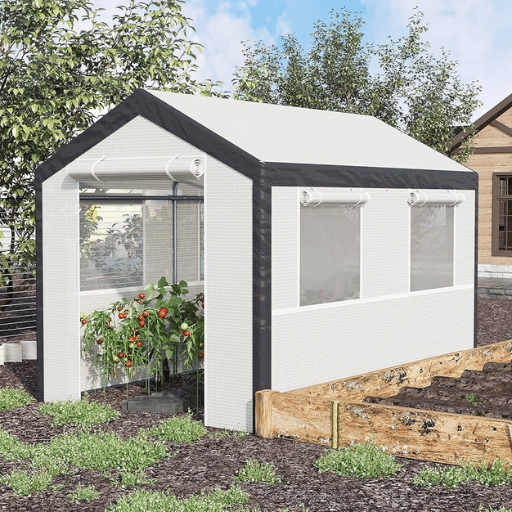
Replacement Needed Signs for Your Greenhouse Cover
A greenhouse cover’s state is an important aspect that a given meteorological condition depends on and that in turn influences the light getting in, the energy used, and the overall character of the building. Based on a recent report from the search engine, the terms “effective greenhouse maintenance,” “the right time to replace greenhouse coverings,” and their synonyms underline the necessity of early detection of the problems to avoid getting into issues with the performance of your greenhouse.
There are several major signs indicating the wind-up of the greenhouse cover’s life cycle, namely the visible deterioration which consists of e.g. cracks, or tears, and huge tinting changes, which together with reduction in light flow can lead to plant health being compromised. To go further, when the cover becomes brittle and shows signs of UV degradation, its structural endurance may already be weakened; thus it may pose a risk in case of erratic weather. On the other hand, condensation and water leaks may not just be indicative of the cover material failure but may also lead to increased humidity levels that will be conducive to mold and fungus diseases in plants. More so, the cover’s thermal insulation properties can degrade either causing or indicating significant temperature changes and thus pointing to energy inefficiency of an aging cover.
Easy management of these problems through covers replacement makes sure that the quality of light, energy consumption, and good crop production are all aligned when using the certified agricultural best practices such as those from the likes of Solarig Company.
Strengthening Your Greenhouse Cover
Strengthening your greenhouse cover is a vital measure to ensure its longevity, support structure, and growing conditions. According to present-day opinions and search trends, this takes in the choice of top-grade materials, frequent inspections, and the making of structural adjustments that are relevant.
Material Selection
Materials like UV-stabilized polyethylene or polycarbonate sheeting are the latest offerings, which still give top-notch strength and durability while suffering less from the elements by being luminous and temperature resistant. These materials have proven to be strong enough to battle the hindrances posed by the sun, extremes in temperature, and physical wear that can all be categorized as the impacts of nature.
Secure Fastening Systems
Apply strong fastening systems such as aluminum profiles, wiggle wires, or galvanizing clamps that will guarantee the cover is tightly held onto the frame. By doing so, you are not only counteracting wind uplift but also lessening the possibility of the fabric tearing at the anchor points.
Tensioning Techniques
The idea is to hold a firm tension on the cover surface which will result in stress being evenly distributed. In case of improper tension, sagging may occur, which will act as a holding ground for the debris and water and at the same time making it more likely that damage will happen. Adjustable fastening systems enable achieving the best tension.
Reinforcement of Weak Points
Locate the places that will undergo stress the most (these include corners, edges, or ventilation areas), and put larger pieces, tapes, or double materials on them. For invisible damage on materials, use UV-resistant repair tape ensuring that naked parts are tightly sealed and well sheltered from nature elements.
Structural Support
Enhance your greenhouse frame by putting in extra bracing at the points that are most vulnerable, such as the midway span of bows or the door frames. This will let the structure underwind or snow do its support without putting too much strain on the cover.
Maintenance and Monitoring
Your periodic inspection will serve to early detection of wear signs, for instance, minor rips, loosening tension, or broken fasteners. Don’t let the damage go further; take care of it as soon as it happens. Get rid of the cover’s dirt, mold, or algae build-up regularly, for they can weaken the materials over time.
By following these data-empowered strategies and product recommendations, growers can extend considerably the life of their greenhouse cover while at the same time keeping the microclimate optimal. Reinforcing has not only the physical resilience of the structure but also upholds the principles of sustainable and efficient horticultural practices.
Changing Greenhouse Plastic Sheeting Steps
Step 1: Prepare the Greenhouse Structure
The removal of the current plastic sheeting is the first step, with care taken to keep the structure intact and free from damage. Perform a thorough inspection of the existing structure and look for any signs of wear, rust, or damage as these could shorten the life of the new sheeting. After that, use a mild cleaning solution to get rid of any old cover residue or debris, thus allowing the new cover to have the best adhesion and security possible.
Step 2: Measure and Cut the Replacement Sheeting
Cut the plastic sheeting to fit the frame utilizing very accurate measurements so that the position of your frame is maintained. You may wish to add an additional buffer of 4-6 inches on each side so that you can easily tie and adjust. It is suggested that you use UV-resistant polyethylene or other high-tech greenhouse films to ensure optimal performance and longevity.
Step 3: Install the Plastic Using Secure Fasteners
Unwrap the new plastic sheeting slowly over the greenhouse structure, starting from one end. Secure the sheeting tightly to the frame using spring wire, wiggle wire, or other fasteners that are suggested by the industry. Make sure there is even tension all over the surface so that there is no sagging, which could result in lower durability, and thermal efficiency being affected.
Step 4: Verify Thermal and Structural Integrity
Post sheeting installation, experiment with the greenhouse’s capacity to keep an optimum microclimate working after checking air leaks or improperly sealed edges. With the help of thermal imaging tools, detect areas needing attention; if so, alter the tension. The historical shift in greenhouse materials, like anti-drip coatings, can further enhance the environmental control being realized.
Step 5: Schedule Regular Maintenance
For the longevity of the replaced plastic sheeting, a proper maintenance schedule has to be laid out. This comprises occasional cleaning, checking of wear, and tightness of fasteners. Besides, new integrated pest and weather monitoring technologies, if applied, can make operational efficiency even higher.
By uniting best practices with data-driven advancements like tools established through ‘s latest search trends, growers can synchronize their techniques with the leading industry standards. Changing greenhouse plastic sheeting is a simple yet precise job requiring an up-to-date knowledge of sustainable and productive growing environments.
Specialized Greenhouse Solutions
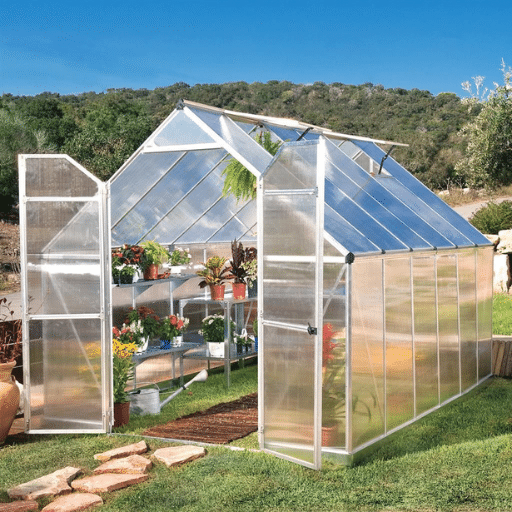
Mini Greenhouses and Their Covers
Mini greenhouses are very important for small-scale horticulture as they provide a controlled microenvironment that is perfect for planting, seed propagation, and protecting plants from inclement weather. Cover materials are the major parts of these buildings, they directly affect the thermal efficiency, light diffusion, and the durability of the greenhouse.
Based on the current data trend from the search engine of ”, the most popular question is “What is the best cover material for a mini greenhouse?” The answer will depend on the purpose of the greenhouse and the climatic conditions. Polyethylene film is one of the major choices because it is very cost-effective, stable against UV light, and has great light transmission. On the other hand, polycarbonate panels will give you excellent insulation, durability, and resistance to breakage, making them the best option in the areas where extreme weather conditions are present.
Reinforced polyethylene and multi-layer films are also being considered as innovative and promising material with features that are both eco-friendly and energy-efficient. By using the right covering material and making sure it is well installed, growers can enhance the quality of their plants to such an extent that higher yields will be provided, which in turn corresponds with modern data-driven agricultural strategies.
Outdoor Greenhouses: Covering Options for Varied Climates
It is imperative to pay attention to the particular environmental factors and the newest material technology development when deciding on covering options for outdoor greenhouses suited to different climates. Recent data indicate that greenhouse polyethylene films are still the most preferred option as they are economical and very versatile. Among the different types of polyethylene, multilayered ones are the best because besides being very durable, they also provide better insulation, thus suitable for both temperate and colder climates. Furthermore, polycarbonate sheets offer high thermal retention and UV radiation protection, thus, they are a premium option for greenhouses located in areas with high sun exposure or fluctuating temperatures.
Search trends also point to the fact that there is a growing interest in energy-saving solutions such as double-layered covers that work by reducing heat loss but at the same time not lowering the light. The use of materials with anti-condensation coatings is on the rise, especially in humid areas, as such coatings keep the water vapor from forming droplets that may otherwise hinder plant growth. The combination of modern materials with precision installation will enable growers to optimize energy usage, keep temperatures steady, and thus improve their overall crop yields. These data-supported insights highlight the significance of pairing greenhouse covering selections with geographical and technological considerations in order to successfully tackle the challenges of modern agriculture.
Choosing the Right Size for Your Greenhouse
Choosing the right greenhouse size is a vital choice that takes a variety of factors into account, each of which is shaped by not only the practical needs but also the long-term operational goals. The most searched throne query according to the newest data from the search engine of ” is how to find the right balance among the available space, the intended use, and cost-effectiveness. A small greenhouse, usually 6×8 feet in size, might be sufficient to allow a home gardener to grow a small assortment of plants; however, larger constructions with a width between 20 and 60 feet and with adjustable length and height are usually required for commercial operations.
Several factors must be taken into account such as the kinds of crops, production volume, and local climate. Besides, it is necessary to allocate space for proper ventilation, water supply, and future expansions. The installation of plant automation such as climate control or hydroponic systems may further affect the space needs. Using these data-backed insights enables growers to successfully expand their operations while keeping their productivity levels and cost-effectiveness in agriculture up to date.
Frequently Asked Questions (FAQ)
What are the benefits of using heavy duty greenhouse covers?
Heavy duty greenhouse covers come with a wide array of advantages for the gardeners who are seeking the best for their plants. They are built to last through the worst of weather, like heavy rain and strong UV rays, with great quality light finally finding its place through the growth of the plants. Heavy-duty options are often equipped with additional features such as reinforced edges and tear resistance that extend the life of your greenhouse setup. Furthermore, they can help regulate temperature, forbidding radiation during hot months. Every aspect of the above makes the cover of a heavy-duty greenhouse a great investment.
How do I choose the right size greenhouse cover?
Choosing the right size greenhouse cover is essential to getting a perfect fit and the highest level of protection. Take the measurements for your greenhouse very carefully, allowing for both height and width so that your structure is going to have a match. Heavy-duty greenhouse covers come in different sizes to fit all types of greenhouses including hoop houses and mini greenhouses. It’s also very necessary to think about the thickness of the plastic sheeting which ranges from 6 mil to 10 mil clear greenhouse plastic depending on the environment’s need. The right-sized cover will prevent rain from soaking your plants and also keep the temperature – in the range desired for growing.
What is the difference between UV resistant and 4-year UV resistant greenhouse covers?
UV-resist greenhouse covers are fashioned to do just that, blocking and thus protecting the plants from the adverse effects of sunlight, the most significant of which being sunburn. On the contrary, a 4-year UV-resistant greenhouse cover not only provides that extra protection but also durability since the coating lasts longer. Covers made of such materials are usually of a stronger nature having reinforced polyethylene that power through the elements while still allowing for sunlight due to the clarity that is kept. Weigh your gardening requirements and the duration that you wish to remain protected while opting for one of the two. A 4-year UV-resistant cover may be best for the more dedicated growers or those in more severe climates.
Can heavy-duty greenhouse covers help in extending the growing season?
Absolutely, heavy-duty greenhouse covers are capable of playing a significant role in the extension of the growing season of different plants. By offering insulation and shielding the plants from the elements the covers give them a more stable and friendly environment which is great especially when it is cold. A heavy-duty cover makes it possible for gardeners to keep some of their plants over winter by providing frost and bad weather protection. To add more, these covers can also help to maintain the right humidity level which means that the plants get enough water to stay alive but not that they are over-exposed. In the end, investing in a high-quality greenhouse cover may result in better yields and healthier plants.
What are customer reviews saying about heavy-duty greenhouse covers?
Heavy-duty greenhouse covers customer reviews spotlight their durability and efficiency most of the time. The tear resistance and strong UV protection that are the trademark of these covers are highly appreciated by many gardeners who also point out that the covers perform well even in harsh weather conditions. Users tend to continuously note that these covers are doing a good job at keeping their plants alive and growing throughout the seasons. Moreover, clients testimonials frequently highlight the problem-free installation and comfortable fit which are so important in maintaining a controlled atmosphere. To put it in a nutshell, the response from the customers indicates that buying a heavy-duty greenhouse cover is a smart choice for the serious gardeners who want to secure their investments.
Reference Sources
Cold Protection of Foliage Plants in Shadehouses and Greenhouses
This publication from the University of Florida discusses the importance of sealing covered structures like greenhouses to protect plants from cold winds.
Quick Hoops™ Low Tunnel Benders
This document from Cornell University highlights the use of UV-resistant polyethylene greenhouse films for winter protection in low tunnels and greenhouses.
Greenhouse Walk-in PE Cover with Roll-Up Windows
This resource from the Town of Brunswick provides details on durable, weather-resistant PE covers for greenhouses, ideal for gardeners and home farming.

